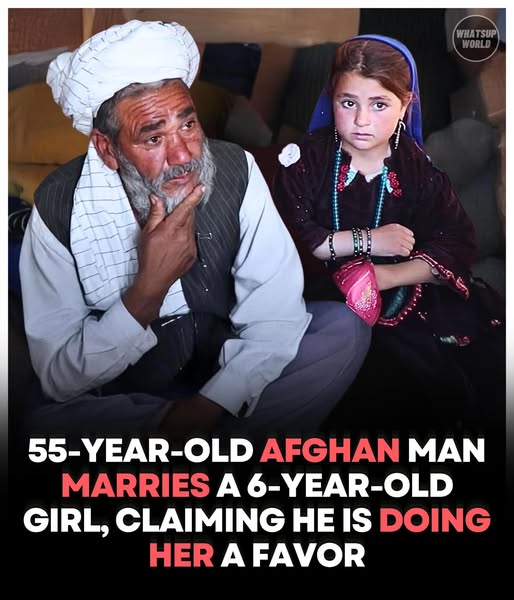Child marriage remains a disturbing reality in many parts of the world, despite increasing global efforts to end the practice. The case of a 55-year-old man from Afghanistan marrying a 6-year-old girl, under the justification of “helping” her and providing financial stability, is a stark reminder of the deep-rooted challenges that persist in some societies. This incident has sparked international outrage, with human rights activists and organizations condemning such marriages as a serious violation of children’s rights.
Understanding the Issue of Child Marriage
Child marriage is defined by the United Nations (UN) and UNICEF as any formal marriage or informal union where one or both of the parties are under 18 years of age. It is illegal in most countries, but still occurs due to cultural, religious, and economic reasons.
Global Statistics on Child Marriage
According to UNICEF and the World Health Organization (WHO):
- Over 12 million girls are married each year before the age of 18.
- 650 million women alive today were married as children.
- In some countries, up to 50% of girls are married before they turn 18.
- Afghanistan, like many other nations, has struggled with child marriage due to poverty, lack of education, and cultural traditions.
The Case in Afghanistan: A Look at the Problem
The case of the 55-year-old man marrying a 6-year-old girl is particularly alarming. The man justified his actions by claiming:
- The girl’s parents were poor and unable to take care of her.
- He was “helping” the family financially.
- He would “wait a few years” before consummating the marriage.
While he may believe that he is providing a better future for the girl, the reality is that this marriage is a clear case of child exploitation.
Why Do Families Agree to Child Marriages?
Many parents in poverty-stricken countries agree to marry off their daughters for reasons such as:
- Financial Hardship – Families struggling to survive may see marriage as a way to reduce their financial burden.
- Cultural and Religious Norms – In some societies, marrying young girls is considered normal and even desirable.
- Lack of Education – Parents who are uneducated may not understand the long-term harm of child marriage.
- Security Concerns – In conflict zones, families sometimes marry off daughters to protect them from violence or sexual exploitation.
The Devastating Impact of Child Marriage on Girls
Child marriage does not protect young girls—instead, it puts them at severe physical, emotional, and psychological risk. Some of the most harmful consequences include:
1. Serious Health Risks
- Early pregnancies put young girls at high risk of maternal mortality and complications during childbirth.
- Girls under 15 are five times more likely to die in childbirth than women in their 20s.
- Obstetric fistula, a severe childbirth injury, is more common in young mothers.
2. Psychological and Emotional Trauma
- Young brides suffer from severe emotional distress, PTSD, depression, and anxiety.
- Many child brides experience isolation from their families and friends, leading to lifelong trauma.
3. Education and Future Opportunities Are Lost
- Child brides often drop out of school and lose their chance for an education.
- Without education, they become financially dependent on their husbands, continuing the cycle of poverty.
4. Increased Risk of Domestic Violence and Abuse
- Child brides have little to no say in their marriages and are at high risk of domestic violence.
- They are often subjected to physical, emotional, and sexual abuse with no legal protection.
International Laws Against Child Marriage
Many international laws and agreements condemn and prohibit child marriage, including:
- United Nations Convention on the Rights of the Child (CRC) – Declares that all children have the right to be protected from forced marriage.
- Convention on the Elimination of All Forms of Discrimination Against Women (CEDAW) – Urges countries to set the legal marriage age at 18 or older.
- Sustainable Development Goals (SDGs) – Goal 5.3 aims to eliminate child marriage worldwide by 2030.
Laws in Afghanistan
Although Afghan law technically prohibits marriage before 16, child marriages still happen, especially in rural areas where laws are weakly enforced. Under Sharia law, which influences Afghanistan’s legal system, some clerics allow girls to marry at puberty or even younger with parental consent.
Steps Needed to Stop Child Marriage
To combat child marriage effectively, governments and international organizations must take urgent action:
1. Strengthening and Enforcing Laws
- Governments must enforce strict laws banning child marriage and punish those who break them.
- Clerics and community leaders must be held accountable for approving illegal marriages.
2. Educating Families and Communities
- Awareness campaigns should educate parents about the dangers of child marriage.
- Schools must teach girls about their rights and encourage them to stay in education.
3. Providing Economic Support to Families
- Families in poverty need financial assistance, job opportunities, and social support to prevent child marriages.
- Programs that empower women economically can help break the cycle of child marriage.
4. Supporting Victims of Child Marriage
- Survivors of child marriage should receive legal, medical, and psychological support.
- Girls forced into marriage should have access to shelters and legal aid to escape abusive situations.
Conclusion: A Call to Action
The story of the 55-year-old man marrying a 6-year-old girl is a human rights crisis that demands global attention. While child marriage is often justified by tradition, religion, or economic hardship, the truth is that it is a form of child abuse that robs young girls of their innocence, safety, and future.
To truly end child marriage, governments, activists, and communities must work together to enforce laws, educate families, and provide better opportunities for young girls. No child should ever be forced into marriage, and it is the responsibility of the world to protect them.
Childhood is for learning, growing, and dreaming—not for marriage.


